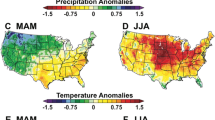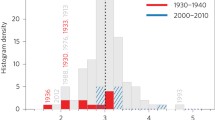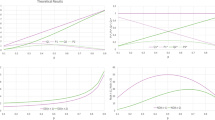Abstract
Three new 159-year long reconstructions of spring, summer, and growing season precipitation totals were developed for northeastern Kansas and northwestern Missouri from five station clusters (Lawrence, Leavenworth, and Manhattan, Kansas; Miami and Oregon, Missouri). Nonstandard observation practices are inherent in the early meteorological data, which can induce an undercount in precipitation measurements, particularly during the cool season. Threshold analyses of these five station clusters indicated undercount can be lessened for daily precipitation totals of 0.50 in. and greater during the warm season (“half-inch threshold”). Therefore, “adjusted reconstructions” of total precipitation for the spring (AMJ), summer (JA), and growing season (AMJJA) were derived using the “half-inch threshold” totals and an estimate of the missing amount between 0.00 and 0.50 in. based on an average of the modern observations at each station (or the nearest available station). The new precipitation reconstructions suggest that the most severe spring drought may have occurred during the mid-19th century, although the potential for undercount is likely highest during the spring season. The most severe summer precipitation deficit is estimated during the 1930s Dust Bowl drought, followed by the summer drought of the 1910s. When precipitation is totaled for the entire growing season, the mid-19th century and Dust Bowl droughts were of approximately equal magnitude and duration in this reconstruction. However, the integration of precipitation and temperature into seasonal measures of effective moisture, using a new 19th century temperature reconstruction for northeastern Kansas, indicates that the 1930s growing season moisture deficit was the most severe and sustained since 1855, highlighting the extraordinarily high temperatures recorded during the 1930s Dust Bowl drought.






Similar content being viewed by others
Explore related subjects
Discover the latest articles and news from researchers in related subjects, suggested using machine learning.References
Bell PR (1981a) The combined solar and tidal influence on climate. In: Sofia SS (ed) Variations of the solar constant. National Aeronautics and Space Administration, Washington, pp 241–256
Bell PR (1981b) Predominant periods in the time series of drought area index for the western high plains AD 1700 to 1962. In: Sofia SS (ed) Variations of the solar constant. National Aeronautics and Space Administration, Washington, pp 257–264
Bollinger CJ (1945) The 22-year solar pattern of rainfall in Oklahoma and Kansas. Bull Am Meteorol Soc 26:376–383
Borchert J (1971) The Dust Bowl in the 1970s. Ann AAG 61:1–22
Burnette DJ (2009) Reconstruction of the eastern Kansas temperature and precipitation records into the mid-19th century using historical sources. Dissertation, University of Arkansas
Burnette DJ, Stahle DW, Mock CJ (2010) Daily mean temperature reconstructed for Kansas from early instrumental and modern observations. J Clim 23:1308–1333
Burt CC (2004) Extreme weather: a guide and record book. W.W. Norton and Company, New York
Cleaveland MK, Stahle DW (1989) Tree ring analysis of surplus and deficit runoff in the White River, Arkansas. Water Resour Res 25:1391–1401
Cook ER, Krusic PJ (2004) North American summer PDSI reconstructions. IGBP PAGES/World Data Center for Paleoclimatology Data Contribution Series No. 2004-045, NOAA/NGDC Paleoclimatology Program, Boulder
Cook ER, Peters K (1981) The smoothing spline: a new approach to stabilizing forest interior tree-ring width series for dendroclimatic studies. Tree-Ring Bull 41:45–53
Cook ER, Meko DM, Stockton CW (1997) A new assessment of possible solar and lunar forcing of the bidecadal drought rhythm in the western United States. J Clim 10:1343–1356
Cook ER, Woodhouse CA, Eakin CM, Meko DM, Stahle DW (2004) Long-term aridity changes in the western United States. Sci 306:1015–1018
Cook BI, Miller RL, Seager R (2008) Dust and sea surface temperature forcing of the 1930s “Dust Bowl” drought. Geophys Res Lett. doi:10.1029/2008GL033486
Cook BI, Miller RL, Seager R (2009) Amplification of the North American “Dust Bowl” drought through human-induced land degradation. Proc Natl Acad Sci 106:4997–5001
Cook ER, Seager R, Heim RR Jr, Vose RS, Herweijer C, Woodhouse C (2010) Megadroughts in North America: placing IPCC projections of hydroclimatic change in a long-term palaeoclimate context. J Quat Sci 25:48–61
Cook BI, Seager R, Miller RL (2011) Atmospheric circulation anomalies during two persistent North American droughts: 1932–1939 and 1948–1957. Clim Dyn 26:2339–2355
Cunfer G (2005) On the Great Plains agriculture and environment. Texas A&M University Press, College Station
Currie RG (1981) Evidence for 18.6 year MN signal in temperature and drought conditions in North America since A.D. 1800. J Geophys Res 86:11,055–11,064
Currie RG (1984a) Evidence for 18.6-year lunar nodal drought in western North America during the past millennium. J Geophys Res 89:1295–1308
Currie RG (1984b) Periodic (18.6-year) and cyclic (11-year) induced drought and flood in western North America. J Geophys Res 89:7215–7230
Dai A, Trenberth KE, Qian T (2004) A global data set of palmer drought severity index for 1870–2002: relationship with soil moisture and effects of surface warming. J Hydrometeorol 5:1117–1130
Daly C, Gibson WP, Taylor GH, Doggett MK, Smith JI (2007) Observer bias in daily precipitation measurements at United States cooperative network stations. Bull Am Meteorol Soc 88:899–912
Darter LJ (1942) List of climatological records in the National Archives. National Archives, Washington
Dodds SF, Burnette DJ, Mock CJ (2009) Historical accounts of the drought and hurricane season of 1860. In: Dupigny-Giroux L-A, Mock CJ (eds) Historical climate variability and impacts in the United States. Springer, London, pp 61–77
Flora SD (1948) The climate of Kansas. Kansas State Board of Agriculture Report, Topeka
Fye FK, Stahle DW, Cook ER (2003) Paleoclimatic analogs to twentieth-century moisture regimes across the United States. Bull Am Meteorol Soc 84:901–909
Garbrecht J, Rossel F (2002) Decade-scale precipitation increase in the Great Plains at the end of the 20th century. J Hydrol Eng 7:64–75
Herweijer C, Seager R, Cook ER, Emile-Geay J (2007) North American droughts of the last millennium from a gridded network of tree-ring data. J Clim 20:1353–1376
Juracek KE, Perry CA, Putnam JE (2001) The 1951 floods in Kansas revisited. U.S. Geological Survey Fact Sheet 041-01, Lawrence
Kohler M (1949) On the use of double-mass analysis for testing the consistency of meteorological records and for making required adjustments. Bull Am Meteorol Soc 30:188–189
Kunkel KE, Changnon SA, Angel JR (1994) Climatic aspects of the 1993 upper Mississippi River basin flood. Bull Am Meteorol Soc 75:811–822
Larson LW, Peck EL (1974) Accuracy of precipitation measurements for hydrologic modeling. Water Resour Res 10:857–863
Malin JC (1946a) Dust storms part one 1850–1860. Kans Hist Q 14:129–133
Malin JC (1946b) Dust storms part two 1861–1880. Kans Hist Q 14:265–296
McCabe GJ, Palecki MA, Betancourt JL (2004) Pacific and Atlantic Ocean influences on multidecadal drought frequency in the United States. Proc Natl Acad Sci 101:4136–4141
Mitchell JM, Stockton CW, Meko DM (1979) Evidence of a 22-year rhythm of drought in the western United States related to the Hale solar cycle since the 17th century. In: McCormac BM, Seliga TA (eds) Solar and terrestrial influences on weather and climate. D. Reidel Publishing Company, Dordrecht, pp 125–143
Mock CJ (1991) Drought and precipitation fluctuations in the Great Plains during the late nineteenth century. Great Plains Res 1:26–56
Mock CJ (2000) Rainfall in the garden of the United States Great Plains, 1870–1889. Clim Chang 44:173–195
Mock CJ, Mojzisek J, McWaters M, Chenoweth M, Stahle DW (2007) The winter of 1827–1828 over eastern North America: a season of extraordinary climatic anomalies, societal impacts, and false spring. Clim Chang 83:87–115
Muhs DR, Holliday VT (1995) Evidence of active dune sands on the Great Plains in the 19th century from accounts of early explorers. Quaternary Res 43:198–208
Namias J (1983) Some causes of United States drought. J Appl Clim Meteorol 22:30–39
Pittock AB (1978) A critical look at long-term sun–weather relationships. Rev Geophys Space Phys 16:400–420
Pittock AB (1983) Solar variability, weather, and climate: an update. Q J R Meteorol Soc 109:23–55
Schubert SD, Suarez MJ, Pegion PJ, Koster RD, Bacmeister JT (2004) On the cause of the 1930s Dust Bowl. Sci 303:1855–1859
Seager R, Harnik N, Robinson WA, Kushnir Y, Ting M, Huang H-P, Velez J (2005a) Mechanisms of ENSO-forcing of hemispherically symmetric precipitation variability. Q J R Meteorol Soc 131:1501–1527
Seager R, Kushnir Y, Herweijer C, Naik N, Velez J (2005b) Modeling of tropical forcing of persistent droughts and pluvials over western North America: 1856–2000. J Clim 18:4065–4088
Stahle DW (1982) International tree-ring data bank. IGBP PAGES/World Data Center for Paleoclimatology, NOAA/NCDC Paleoclimatology Program, Boulder
Stahle DW, Cleaveland MK (1988) Texas drought history reconstructed and analyzed from 1698 to 1980. J Clim 1:59–74
Stahle DW, Cook ER, Cleaveland MK, Therrell MD, Meko DM, Grissino-Mayer H, Watson E, Luckman BH (2000) Tree-ring data document 16th century megadrought over North America. EOS Trans Am Geophys Union 81:121–125
Tannehill IR (1947) Drought and it’s causes and effects. Princeton University Press, London
Thornthwaite CW (1948) An approach toward a rational classification of climate. Geogr Rev 38:55–94
Torrence C, Compo GP (1998) A practical guide to wavelet analysis. Bull Am Meteorol Soc 79:61–78
Wahl EW (1968) A comparison of the climate of the eastern United States during the 1830s with the current normals. Mon Weather Rev 96:73–82
Warrick RA, Bowden MJ (1981) The changing impact of droughts in the Great Plains. In: Lawson MP, Baker ME (eds) The Great Plains: perspectives and prospects. University of Nebraska Press, Lincoln, pp 111–137
Woodhouse C, Overpeck J (1998) 2000 years of drought variability in the central United States. Bull Am Meteorol Soc 79:2693–2714
Worster D (2004) Dust Bowl: the southern plains in the 1930s. Oxford University Press, New York
Acknowledgments
This research was sponsored by the National Science Foundation (DDRI Grant BCS-0622894 and ATM-0753399). We thank the Western Historical Manuscripts Collection at the University of Missouri-Columbia for their assistance with the Amos H. Sullivan papers, Cary Mock for valuable comments throughout this research project, and Ed Cook for very helpful advice on the calculation of effective moisture.
Author information
Authors and Affiliations
Corresponding author
Electronic supplementary material
Below is the link to the electronic supplementary material.
ESM 1
(DOC 256 kb)
Rights and permissions
About this article
Cite this article
Burnette, D.J., Stahle, D.W. Historical perspective on the dust bowl drought in the central United States. Climatic Change 116, 479–494 (2013). https://doi.org/10.1007/s10584-012-0525-2
Received:
Accepted:
Published:
Issue Date:
DOI: https://doi.org/10.1007/s10584-012-0525-2




